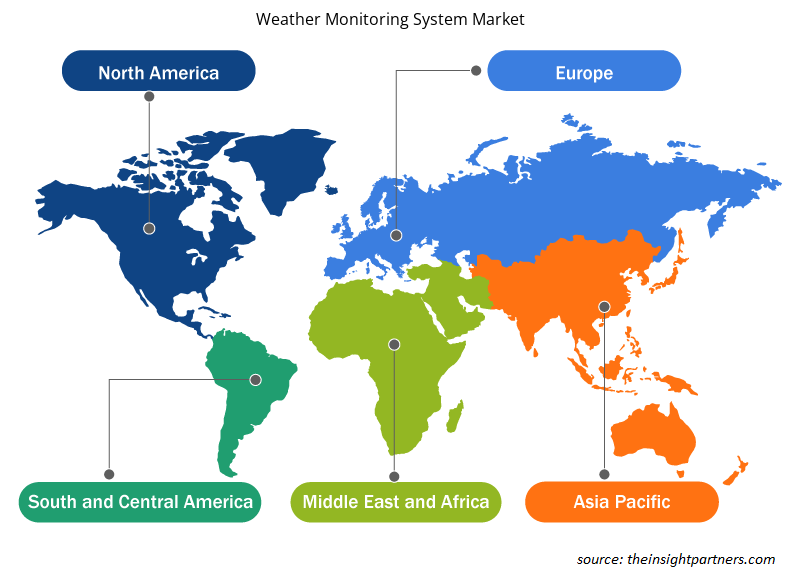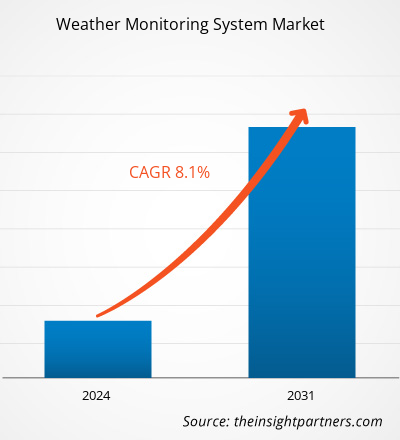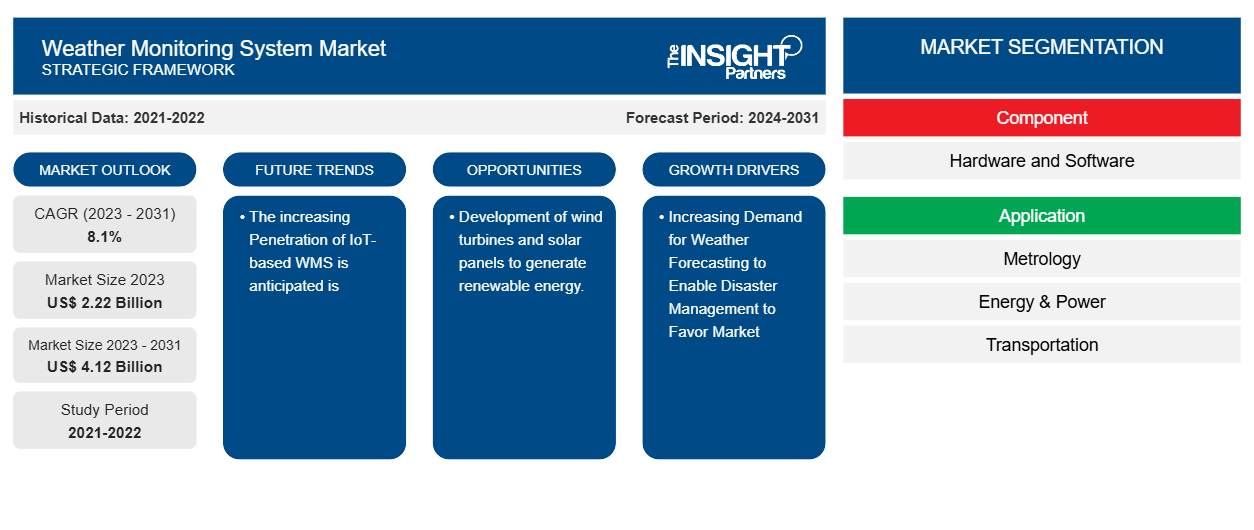Si prevede che la dimensione del mercato dei sistemi di monitoraggio meteorologico (WMS) raggiungerà i 4,12 miliardi di dollari entro il 2031, rispetto ai 2,22 miliardi di dollari del 2023. Si prevede che il mercato registrerà un CAGR dell'8,1% nel periodo 2023-2031. Il crescente utilizzo delle previsioni meteorologiche per consentire la gestione dei disastri e la crescente domanda di previsioni meteorologiche nel settore dell'aviazione saranno probabilmente tendenze e driver chiave nel mercato dei sistemi di monitoraggio meteorologico.
Analisi di mercato del sistema di monitoraggio meteorologico
Il mercato dei sistemi di monitoraggio meteorologico sta vivendo una crescita sostanziale a livello globale. Questa crescita è attribuita al modello di cambiamento climatico che porta a incertezze meteorologiche e al crescente utilizzo delle previsioni meteorologiche per consentire la gestione dei disastri. Inoltre, aumento della produzione di energia rinnovabile, aumento delle capacità di elaborazione dei supercomputer per le previsioni meteorologiche e crescente penetrazione di WMS basati su IoT.
Panoramica del mercato dei sistemi di monitoraggio meteorologico
La sorveglianza o l'analisi continua o periodica dello stato del clima e dell'atmosfera, comprese variabili come temperatura, umidità, velocità del vento e pressione barometrica. Inoltre, i sensori di temperatura e umidità sono i sensori meteorologici più frequentemente utilizzati. Possono essere utilizzati per calcolare un indice di calore, capire se le piante sono a rischio di danni a causa di troppo calore o capire se è sicuro lavorare in una determinata area.
Personalizza questo report in base alle tue esigenze
Riceverai la personalizzazione gratuita di qualsiasi report, comprese parti di questo report, o analisi a livello nazionale, pacchetto dati Excel, oltre a usufruire di grandi offerte e sconti per start-up e università
-
Scopri le principali tendenze di mercato in questo rapporto.Questo campione GRATUITO includerà analisi di dati che spaziano dalle tendenze di mercato alle stime e alle previsioni.
Driver e opportunità del mercato dei sistemi di monitoraggio meteorologico
La crescente domanda di previsioni meteorologiche per consentire la gestione dei disastri favorisce il mercato
La crescente domanda di previsioni meteorologiche per consentire la gestione dei disastri è in effetti un fattore trainante per il mercato dei sistemi di monitoraggio meteorologico. I monitor/stazioni meteorologiche fungono da strumenti essenziali nella preparazione e nella risposta ai disastri. Fornendo dati meteorologici accurati e tempestivi, questi monitor consentono a individui, comunità e autorità di pianificare, mitigare i rischi e rispondere in modo efficiente alle catastrofi. Le stazioni meteorologiche fungono da ponte tra le osservazioni meteorologiche e la gestione dei disastri, promuovendo società più sicure e resilienti. Con il continuo progresso della tecnologia, l'adozione di approcci innovativi e l'integrazione di nuove capacità rafforzeranno il ruolo delle stazioni meteorologiche nel futuro della gestione dei disastri. Pertanto, considerando i parametri di cui sopra, il crescente utilizzo delle previsioni meteorologiche per consentire la gestione dei disastri sta agendo come uno dei fattori trainanti per la crescita del mercato dei sistemi di monitoraggio meteorologico.
Sviluppo di turbine eoliche e pannelli solari per generare energia rinnovabile.
Un WMS è uno dei componenti chiave di una centrale solare. La sua funzione è quella di raccogliere dati sui parametri meteorologici quali temperatura superficiale del modulo, radiazione solare, temperatura ambiente, velocità del vento ecc., in qualsiasi sito fotovoltaico solare, il che aiuta a monitorare l'efficienza e le prestazioni della centrale elettrica. L'ulteriore analisi di questi dati rispetto all'output dell'impianto aiuta ad analizzare e migliorare le prestazioni dell'impianto. Inoltre, per la misurazione dei dati meteorologici della centrale eolica , la stazione meteorologica basata sul data logger SmartSolo è installata sulla torre meteorologica permanente per misurare la velocità e la direzione del vento a due altezze, nonché la temperatura, l'umidità relativa e la pressione dell'aria. Pertanto, grazie ai parametri di cui sopra, si prevede che lo sviluppo di turbine eoliche e pannelli solari per generare energia rinnovabile offrirà diverse opportunità per il mercato dei sistemi di monitoraggio meteorologico nei prossimi anni.
Analisi della segmentazione del rapporto di mercato del sistema di monitoraggio meteorologico
I segmenti chiave che hanno contribuito alla derivazione dell'analisi di mercato del sistema di monitoraggio meteorologico sono i componenti e l'applicazione.
- In base al componente, il mercato dei sistemi di monitoraggio meteorologico è diviso in hardware e software. Si prevede che il segmento hardware detenga una quota di mercato significativa nel periodo di previsione.
- Per applicazione, il mercato è segmentato in metrologia, energia e potenza, trasporti, aviazione e altri. Si prevede che il segmento della metrologia detenga una quota di mercato significativa nel periodo di previsione.
Analisi della quota di mercato del sistema di monitoraggio meteorologico per area geografica
L'ambito geografico del rapporto di mercato sui sistemi di monitoraggio meteorologico è suddiviso principalmente in cinque regioni: Nord America, Asia Pacifico, Europa, Medio Oriente e Africa, e Sud e Centro America.
Il Nord America ha dominato il mercato dei sistemi di monitoraggio meteorologico. Il mercato del Nord America è segmentato in Stati Uniti, Canada e Messico. Le tendenze di adozione di tecnologie elevate in vari settori nella regione del Nord America hanno alimentato la crescita del mercato dei sistemi di monitoraggio meteorologico. Fattori come l'adozione crescente di strumenti digitali, l'elevata spesa tecnologica da parte delle agenzie governative e il modello di cambiamento climatico nella regione stanno portando a incertezze meteorologiche e si prevede che il crescente utilizzo delle previsioni meteorologiche per consentire la gestione dei disastri guiderà la crescita del mercato dei sistemi di monitoraggio meteorologico del Nord America. Inoltre, una forte enfasi sulla ricerca e sviluppo nelle economie sviluppate di Stati Uniti e Canada sta costringendo gli operatori nordamericani a portare sul mercato soluzioni tecnologicamente avanzate. Inoltre, gli Stati Uniti hanno un gran numero di operatori del mercato dei sistemi di monitoraggio meteorologico che si sono sempre più concentrati sullo sviluppo di soluzioni innovative. Tutti questi fattori contribuiscono alla crescita del mercato dei sistemi di monitoraggio meteorologico nella regione.
Approfondimenti regionali sul mercato dei sistemi di monitoraggio meteorologico
Le tendenze regionali e i fattori che influenzano il mercato dei sistemi di monitoraggio meteorologico durante il periodo di previsione sono stati ampiamente spiegati dagli analisti di Insight Partners. Questa sezione discute anche i segmenti e la geografia del mercato dei sistemi di monitoraggio meteorologico in Nord America, Europa, Asia Pacifico, Medio Oriente e Africa e America meridionale e centrale.

- Ottieni i dati specifici regionali per il mercato dei sistemi di monitoraggio meteorologico
Ambito del rapporto di mercato sul sistema di monitoraggio meteorologico
| Attributo del report | Dettagli |
|---|---|
| Dimensioni del mercato nel 2023 | 2,22 miliardi di dollari USA |
| Dimensioni del mercato entro il 2031 | 4,12 miliardi di dollari USA |
| CAGR globale (2023-2031) | 8,1% |
| Dati storici | 2021-2022 |
| Periodo di previsione | 2024-2031 |
| Segmenti coperti |
Per componente
|
| Regioni e Paesi coperti |
America del Nord
|
| Leader di mercato e profili aziendali chiave |
|
Densità degli attori del mercato del sistema di monitoraggio meteorologico: comprendere il suo impatto sulle dinamiche aziendali
Il mercato dei sistemi di monitoraggio meteorologico sta crescendo rapidamente, spinto dalla crescente domanda degli utenti finali dovuta a fattori quali l'evoluzione delle preferenze dei consumatori, i progressi tecnologici e una maggiore consapevolezza dei vantaggi del prodotto. Con l'aumento della domanda, le aziende stanno ampliando le loro offerte, innovando per soddisfare le esigenze dei consumatori e capitalizzando sulle tendenze emergenti, il che alimenta ulteriormente la crescita del mercato.
La densità degli operatori di mercato si riferisce alla distribuzione di aziende o società che operano in un particolare mercato o settore. Indica quanti concorrenti (operatori di mercato) sono presenti in un dato spazio di mercato in relazione alle sue dimensioni o al valore di mercato totale.
Le principali aziende che operano nel mercato dei sistemi di monitoraggio meteorologico sono:
- Vaisala
- Tocco della Trinità
- Società a responsabilità limitata Trafitek Solutions Private Ltd.
- Telegrafia come
- Sistemi di rilevamento fulmini Boltek
- Spiriti liberi Green Labs Pvt Ltd
Disclaimer : le aziende elencate sopra non sono classificate secondo un ordine particolare.

- Ottieni la panoramica dei principali attori del mercato dei sistemi di monitoraggio meteorologico
Notizie di mercato e sviluppi recenti del sistema di monitoraggio meteorologico
Il mercato dei sistemi di monitoraggio meteorologico viene valutato raccogliendo dati qualitativi e quantitativi dopo la ricerca primaria e secondaria, che include importanti pubblicazioni aziendali, dati associativi e database. Di seguito sono elencati alcuni degli sviluppi nel mercato dei sistemi di monitoraggio meteorologico:
- L'11 aprile, un razzo SpaceX Falcon 9 ha lanciato un satellite per il monitoraggio meteorologico della US Space Force. (Fonte: sito web aziendale SpaceX, aprile 2024)
- L'Indian Space Research Organisation (Isro) ha lanciato con successo INSAT-3DS, un satellite di monitoraggio meteorologico e di allerta disastri. Il satellite è stato lanciato in cima al razzo GSLV-F14 da Sriharikota. (Fonte: ISRO, comunicato stampa, febbraio 2024)
Copertura e risultati del rapporto di mercato sul sistema di monitoraggio meteorologico
Il rapporto "Dimensioni e previsioni del mercato del sistema di monitoraggio meteorologico (2021-2031)" fornisce un'analisi dettagliata del mercato che copre le seguenti aree:
- Dimensioni e previsioni del mercato dei sistemi di monitoraggio meteorologico a livello globale, regionale e nazionale per tutti i principali segmenti di mercato interessati dall'ambito di applicazione.
- Tendenze del mercato dei sistemi di monitoraggio meteorologico e dinamiche di mercato quali conducenti, limitazioni e opportunità chiave.
- Analisi dettagliata delle cinque forze PEST/Porter e SWOT.
- Analisi di mercato dei sistemi di monitoraggio meteorologico che copre le principali tendenze del mercato, il quadro globale e regionale, i principali attori, le normative e i recenti sviluppi del mercato.
- Analisi del panorama industriale e della concorrenza che copre la concentrazione del mercato, l'analisi delle mappe di calore, i principali attori e gli sviluppi recenti per il mercato dei sistemi di monitoraggio meteorologico.
- Profili aziendali dettagliati.
- Analisi storica (2 anni), anno base, previsione (7 anni) con CAGR
- Analisi PEST e SWOT
- Valore/volume delle dimensioni del mercato - Globale, Regionale, Nazionale
- Industria e panorama competitivo
- Set di dati Excel
Report recenti
Testimonianze
Motivo dell'acquisto
- Processo decisionale informato
- Comprensione delle dinamiche di mercato
- Analisi competitiva
- Analisi dei clienti
- Previsioni di mercato
- Mitigazione del rischio
- Pianificazione strategica
- Giustificazione degli investimenti
- Identificazione dei mercati emergenti
- Miglioramento delle strategie di marketing
- Aumento dell'efficienza operativa
- Allineamento alle tendenze normative























 Ottieni un campione gratuito per - Mercato dei sistemi di monitoraggio meteorologico
Ottieni un campione gratuito per - Mercato dei sistemi di monitoraggio meteorologico